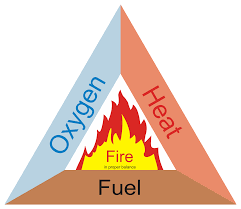Having an understanding of the fire triangle is useful knowledge, because in the event of a fire, if one of these elements can be removed, it might help to reduce the intensity of a fire or help it smoulder out. The fire triangle represents the three elements that a fire has to have to remain ignited, namely:
The above three elements must be combined in the right proportions for a fire to occur, so if oxygen, heat or fuel can be removed, the fire will be extinguished or eventually smoulder out.

As you can now see, learning about the fire triangle is a good way to understand the elements of fire and should form an essential component of the fire safety training your staff should receive.
For safety sake, nobody should ever attempt to extinguish a fire unless in a dire emergency. If you find a fire or are alerted by a fire alarm system and need to evacuate a building, the first response should be to find the nearest fire exit. If however the exit route is blocked, using the right fire extinguisher to create a pathway might be an option to aid escape.
Fire officers will always make an assessment of the fire before deciding the best strategies. Water is often one of the first responses that will be used as an extinguishing agent because it will cool the fire and reduce heat. In making this decision they will also have considered the whether the fire has been ignited by a chemical reaction involving metals such as titanium, lithium and magnesium. These are called Class D fires and require a very different approach involving dry powder solutions because application of water will exacerbate the combustion.
A fire also needs fuel to burn, which can be anything from wood, plastics, fabric, paper and other combustible materials. Again removing the fuel will extinguish the fire. This is why close attention should be paid to areas where recycling paper bins and other commercial waste is stored to ensure these fuels cannot be easily ignited and cause a fire risk.
The last element is oxygen, which as it is all around us can be hard to eliminate, particularly in open spaces. However, this is why buildings are specified with fire doors and why they should always be kept closed and not propped open. If the fire can be contained within the area protected by the fire door and not fuelled by other sources, it will eventually use up all the oxygen and burn out. This is also why it is good practice to have a range of fire safety equipment available, which may also include buckets of sand and fire blankets in more vulnerable places such as kitchens.
IT server rooms are another important area that require specialist protection. These areas are usually protected by fire suppression systems which expel a chemical agent that extinguishes the fire.
Ensuring that employees have a basic understanding of the causes of fire with knowledge of the fire triangle is an important part of basic fire safety training. When this training is supported with robust fire safety policies and a fire alarm system that is fully maintained in accordance with fire safety legislation the risk and impact of a fire can be significantly reduced.

Grahame has worked in the fire and security industry since 1979. He was instrumental in developing a small, regional fire and security alarm company into one of the industry’s most successful specialist companies.